The equlibrium constant for the reaction $ 2N{{O}_{2}}(g) \rightleftharpoons 2NO(g)+{{O}_{2}}(g) $ is $ 2\times {{10}^{-6}} $ at $ 185{}^\circ C $ . Then the equilibrium constant for the reaction, $ 4NO(g)+2{{O}_{2}}(g) \rightleftharpoons $ $ 2N{{O}_{2}}(g) $ at the same temperature would be
- $ 2.5\times {{10}^{-5}} $
- $ 4\times {{10}^{-12}} $
- $ 2.5\times {{11}^{11}} $
- $ 2\times {{10}^{6}} $
The Correct Option is C
Solution and Explanation
Top Questions on Law Of Chemical Equilibrium And Equilibrium Constant
- Consider the equilibrium: \[ \text{CO(g)} + \text{3H}_2\text{(g)} \rightleftharpoons \text{CH}_4\text{(g)} + \text{H}_2\text{O(g)} \] If the pressure applied over the system increases by two fold at constant temperature then:
- JEE Main - 2025
- Chemistry
- Law Of Chemical Equilibrium And Equilibrium Constant
The equilibrium constant for decomposition of $ H_2O $ (g) $ H_2O(g) \rightleftharpoons H_2(g) + \frac{1}{2} O_2(g) \quad (\Delta G^\circ = 92.34 \, \text{kJ mol}^{-1}) $ is $ 8.0 \times 10^{-3} $ at 2300 K and total pressure at equilibrium is 1 bar. Under this condition, the degree of dissociation ($ \alpha $) of water is _____ $\times 10^{-2}$ (nearest integer value). [Assume $ \alpha $ is negligible with respect to 1]
- JEE Main - 2025
- Chemistry
- Law Of Chemical Equilibrium And Equilibrium Constant
- In the following system, $ PCl_5(g) \rightleftharpoons PCl_3(g) + Cl_2(g) $ at equilibrium, upon addition of xenon gas at constant T and p, the concentration of
- JEE Main - 2025
- Chemistry
- Law Of Chemical Equilibrium And Equilibrium Constant
- Given below are two statements:
Statement I: A catalyst cannot alter the equilibrium constant ($ K_c $) of the reaction, temperature remaining constant.
Statement II: A homogeneous catalyst can change the equilibrium composition of a system, temperature remaining constant.
In the light of the above statements, choose the correct answer from the options given below.- JEE Main - 2025
- Chemistry
- Law Of Chemical Equilibrium And Equilibrium Constant
- What is the pH of 0.365% (w/V) HCl aqueous solution? (HCl=36.5 u), (log 0.365=−0.4377)
- TS EAMCET - 2025
- Chemistry
- Law Of Chemical Equilibrium And Equilibrium Constant
Questions Asked in KEAM exam
- A lift having mass 1000kg moves upward against a frictional force of 2000N. Power given by motor is 36000W. What is the velocity of the lift?
- KEAM - 2025
- Speed, Time and Distance
- Solve for \( a \) and \( b \) given the equations: \[ \sin x + \sin y = a, \quad \cos x + \cos y = b, \quad x + y = \frac{2\pi}{3} \]
- KEAM - 2025
- Trigonometry
- If \( A \) is a \( 3 \times 3 \) matrix and \( |B| = 3|A| \) and \( |A| = 5 \), then find \( \left| \frac{\text{adj} B}{|A|} \right| \).
- KEAM - 2025
- Matrix Operations
- An unbiased die is tossed until a sum \( S \) is obtained. If \( X \) denotes the number of times tossed, find the ratio \( \frac{P(X = 2)}{P(X = 5)} \).
- KEAM - 2025
- Probability
- If $ f(x) = \log 3 - \sin x $, $ y = f(f(x)) $, find $ y(0) $.
- KEAM - 2025
- Functions
Concepts Used:
Law of Chemical Equilibrium
Law of Chemical Equilibrium states that at a constant temperature, the rate of a chemical reaction is directly proportional to the product of the molar concentrations of the reactants each raised to a power equal to the corresponding stoichiometric coefficients as represented by the balanced chemical equation.
Let us consider a general reversible reaction;
A+B ↔ C+D
After some time, there is a reduction in reactants A and B and an accumulation of the products C and D. As a result, the rate of the forward reaction decreases and that of backward reaction increases.
Eventually, the two reactions occur at the same rate and a state of equilibrium is attained.
By applying the Law of Mass Action;
The rate of forward reaction;
Rf = Kf [A]a [B]b
The rate of backward reaction;
Rb = Kb [C]c [D]d
Where,
[A], [B], [C] and [D] are the concentrations of A, B, C and D at equilibrium respectively.
a, b, c, and d are the stoichiometric coefficients of A, B, C and D respectively.
Kf and Kb are the rate constants of forward and backward reactions.
However, at equilibrium,
Rate of forward reaction = Rate of backward reaction.

Kc is called the equilibrium constant expressed in terms of molar concentrations.
The above equation is known as the equation of Law of Chemical Equilibrium.